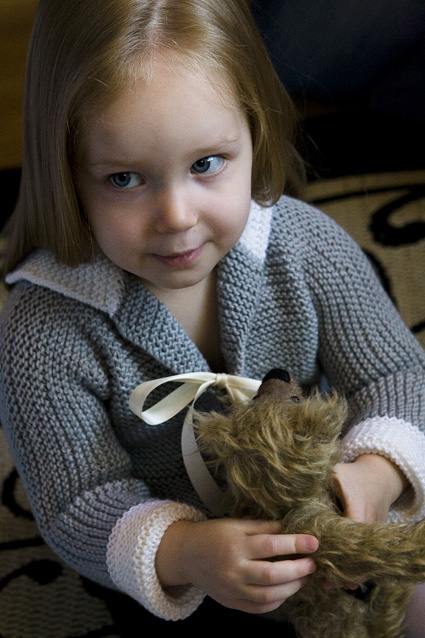

|
 by Franklin Habit, translated from Lion Yarn Book:
A Manual of Worsted Work for Those Who
Knit and Crochet by
Lion Brand Yarns (1916)
|
|
| Tweet | |
| SIZE |
2-3 years |
|
FINISHED MEASUREMENTS |
Chest: 24 inches |
 |
|
MATERIALS Notions |
| GAUGE |
20 sts/20 ridges = 4 inches in stockinette stitch before blocking |
|
PATTERN NOTES |
The piece is worked entirely in garter stitch. The body and sleeves are knit first, in one piece, beginning with the back. Cuffs and collar are added before the two side/underarm seams are sewn. Note that the front panel is considerably larger than the back due to stitches that are cast on when working the collar’s front placket. This creates a nice a-line shape. Gauge and needle selection: You’ll find that the gauge indicated creates a firm fabric – not stiff, but tight enough to minimize stretching and drooping. To get gauge, you may well find yourself using a needle two or even three sizes smaller than you would normally choose for knitting the same yarn in stockinette. Historic gauge and fiber: The figures used in the original pattern indicate a slightly finer gauge of 6 sts to the inch, to be worked in a pure wool yarn equivalent to a modern sport weight. If you wish to work at this gauge, substitute the following numbers for those in the modern pattern:
and adjust the rest of the numbers accordingly. Counting Garter Rows. Garter stitch (working flat, knit all stitches) forms ridges which are more prominent in the finished fabric than individual rows. The pattern therefore counts ridges more often than rows. Two rows create one ridge. Unless otherwise noted, always count ridges on the RS of the fabric.Knitted Cast On. For a tutorial, see "Knitting On" here BO in Purl on RS row. This small detail isn’t called for in the original pattern, but it results in a garter stitch edge so neat and elegant that it has become my go-to technique for binding off garter stitch. There’s a tutorial here. Sewing Seams. I strongly recommend mattress stitch, which is strong, flexible, and becomes virtually invisible in this project. |
|
DIRECTIONS |
BODY |
| ABOUT THE DESIGNER |
| Franklin Habit, the author of It
Itches: A Stash of Knitting Cartoons (Interweave
Press) and proprietor of the popular knitting
blog The
Panopticon is five feet, four inches tall.
This middy jumper has afforded him the welcome opportunity to knit a garment for someone who is smaller than himself, but not actually a doll. He doesn’t mind being small, really. It makes airplane travel easier. He spends a lot of time on airplanes, flying around to teaching gigs at fiber festivals. Gosh, his life is hard. |
| Pattern & images © 2012. Franklin Habit. |